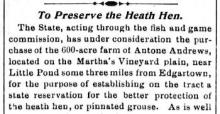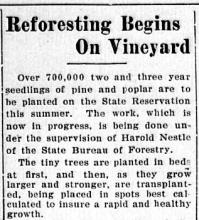In a move that is expected to knock down many established barriers to the land protection movement, The Nature Conservancy announced this week that it will buy and put into private conservation 103 acres of land along the Edgartown Great Pond. The property just last year was planned for a private luxury golf club.
Formerly owned by Katharine and Robert Bigelow, the property stretches from Meetinghouse Way to the Kanomika Neck shore of the Great Pond fronting Mashacket Cove, and includes a large expanse of globally rare sandplain grassland.
Although the actual sale price will not be disclosed for about two months, the Conservancy confirmed that it will pay top dollar for the property.
“This project goes to show that the conservation community is a viable player on this landscape, no matter how high the stakes get,” declared Tom Chase, the director of the Islands Program for The Nature Conservancy.
“This is a counterpart to the skepticism about whether conservation can compete in a superheated environment. It can compete — and it is very important to put that back on the table,” said Robert T. Wilber, director of land protection for The Nature Conservancy.
“This really demonstrates that there is a conservation alternative even in the face of rapidly escalating real estate prices and intense development pressure,” said Wayne Klockner, the Massachusetts director for The Nature Conservancy.
The Conservancy will buy the land from Meetinghouse Golf LLC, the development group that had planned to build an 18-hole private golf club on some 200 acres owned by the MacKenty and Bigelow families.
The Meetinghouse Golf Club plan was rejected by the Martha’s Vineyard Commission by one vote in May 1999.
Meetinghouse Golf recently signed an agreement to buy the 103-acre property from the Bigelows, and then signed an agreement to sell the property to the Conservancy. The Bigelows have retained ownership of six undeveloped acres at Kanomika Neck.
Sale price will be disclosed at the time of the closing, sometime in July.
It was known some months ago that the sale price for the MacKenty and Bigelow land was $11 million. It is also known that The Nature Conservancy will pay a price that is not less than that number.
The Nature Conservancy plans to place a conservation restriction on nearly all of the former Bigelow land and then sell it to a private conservation buyer.
The restriction will permit no additional development on the property beyond what is there currently — one house, a barn and outbuildings. It will also allow the Conservancy to carry out an aggressive land management program aimed at preserving and restoring a large area of globally rare sandplain grassland, through prescribed burning and clearing.
“This will accomplish several things,” said Mr. Chase. “It will eliminate development, it will provide for protection of the watershed of the Edgartown Great Pond in private ownership, it will remain on the tax rolls, although in a reduced way because there will not be multiple houses, there will be a reduced impact to the community in terms of services, and it will restore a globally rare habitat.”
The purchase is being paid out of The Nature Conservancy’s revolving land acquisition fund. “No donor has walked up and given us the money to do this,” Mr. Chase said. He said the Conservancy plans to recoup the entire sale price through the sale to a private buyer.
“Conservation is not only viable, but it is viable with people living on the land,” he added.
The Nature Conservancy currently manages some 2,000 acres of land on the Vineyard, all of it in private ownership and most of it owned by old-time Islanders, Mr. Chase said.
He singled out Meetinghouse Golf partners Richard Friedman, Rosario Lattuca and M. Anthony Fisher for special praise in helping to make the conservation purchase possible.
The Nature Conservancy did not deal directly with the Bigelow family.
“It was a very difficult negotiation, and we were particularly pleased that we had the help of Dick Friedman, Russ Lattuca and others in Meetinghouse Golf,” Mr. Chase said. “I am grateful to those two men and to Tony Fisher for being clear-headed professional business people who helped make a deal happen.”
Mr. Fisher said yesterday that it was the right deal.
“It was the right answer to the problem for this piece of land,” he said. “And it was clear that this was not motivated by greed; this was motivated by what was right for the Vineyard.”
When the MVC voted on the golf course plan a year ago, one member of the commission who voted against the plan compared the land and its sandplain habitat with the redwood forests in California.
“This is a vanishing, magnificent ecosystem that needs to be protected and cherished,” said commission member Tristan Israel.
Last September the Meetinghouse Golf partners announced they would merge memberships with the Vineyard Golf Club, a group that had already won approval for a golf course project off the West Tisbury Road in Edgartown.
The agreement cleared the way for the conservation group to negotiate to buy the Bigelow and MacKenty land.
The fate of the Jeremiah MacKenty land, which includes some 50 acres abutting the former Bigelow land, is still uncertain.
Mr. Wilber did not rule out the possibility that the Conservancy would negotiate an additional purchase.
“We have a continued interest in seeing that the MacKenty land ends up in conservation,” he said.
The land now under sale agreement to the Conservancy includes pine and oak woodlands, open grasslands, and about a half a mile of shorefront on the Edgartown Great Pond. Sandplain blue-eyed grass and sandplain flax grow on the property, which is also a habitat for the imperial moth. The last remaining habitat in Massachusetts for the imperial moth is on Martha’s Vineyard.
Vegetation restoration on the former Bigelow land will include opening up more grassland and restoring habitat for many more species, including the northern harrier.
Mr. Chase said the property comes with an outstanding biological inventory already in place because of the golf course development plan.
He described the conservation plan for the property as more aggressive than usual. “We want to raise the stakes, to be as aggressive as possible for both the human and the natural community,” he said.
Mr. Klockner agreed.
“This is not new ground for us in a national sense, but it is relatively new for us here in Massachusetts. But a conservation buyer approach enables us to do it, given the expense of trying to purchase land on the Vineyard,” he said.
Mr. Chase said much of the future of the property and how it is used will depend on the conservation buyer.
He did not rule out some kind of public access, although he said the Conservancy cannot require it.
But Mr. Chase, Mr. Klockner and Mr. Wilbur all said the public benefits from this purchase go far beyond the issue of public access.
“One hundred acres of land fronting on a town way and with a wide viewshed from the pond — I feel there are substantial public benefits involved,” said Mr. Wilber.
“The most obvious public benefits are the maintenance of the Vineyard’s character and protecting the water quality of the Edgartown Great Pond,” said Mr. Chase.
“I think public benefit should be measured by a number of yardsticks beyond just public access,” said Mr. Klockner. “I think it’s undeniable that preserving natural habitats around the Great Ponds are going to benefit water quality in the Great Ponds, and in turn that will benefit those who fish or shellfish in the Great Ponds.”
Mr. Chase said the land purchase sets a new standard for conservation.
“This is just the beginning of a new wave of conservation; we are going to see as a community many more good things coming out of this,” he said. He concluded:
“The key is to provide a comprehensive vision for the entire Island. By that I mean we need to start integrating all the concerns that face the Island rather than talk about each one of them alone. Affordable housing, traffic, education, transportation and conservation are all part of the same package — they are not competing elements.”









Comments